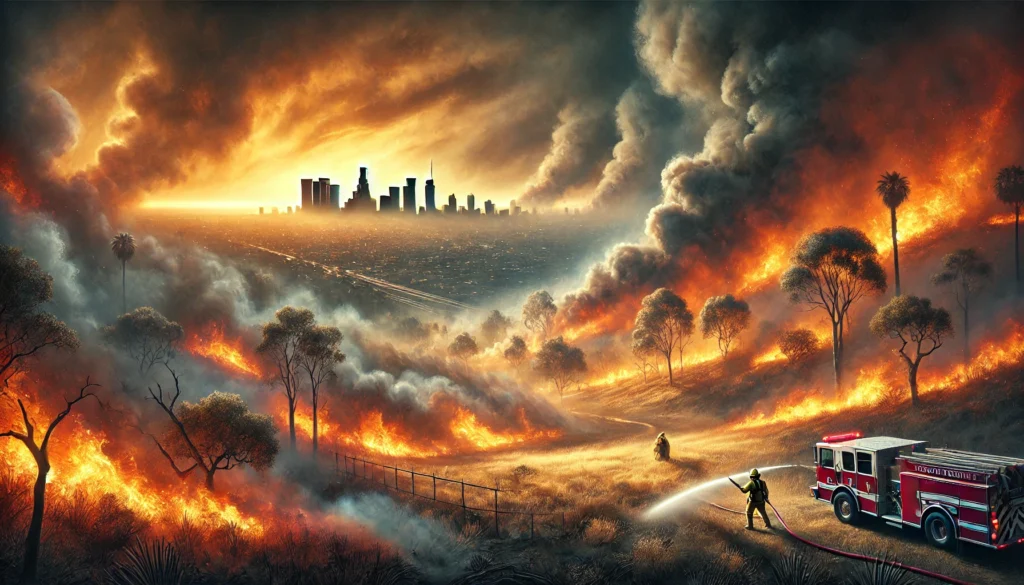The Unyielding Battle Fires in Los Angeles | Los Angeles is a vibrant city known for its sunshine, bustling industries, and iconic landscapes. But behind its glittering facade lies a persistent challenge: fires that wreak havoc on communities and ecosystems. Over the years, Los Angeles has become synonymous with destructive wildfires, and the situation only seems to be intensifying.

Table of Contents
Climate Change and Rising Temperatures
The Unyielding Battle Fires in Los Angeles | The soaring temperatures in Los Angeles, coupled with prolonged droughts, create the perfect recipe for wildfires. Dry vegetation acts as fuel, and a single spark can ignite vast areas, leading to uncontrollable infernos.
Urban Expansion into Wildlands
The Unyielding Battle Fires in Los Angeles | As Los Angeles grows, residential areas encroach upon natural landscapes. This urban sprawl not only increases fire risks but also makes firefighting operations more complex.
Human Activities and Accidental Ignitions
The Unyielding Battle Fires in Los Angeles | A significant portion of fires is human-induced, whether through negligence, illegal campfires, or even arson. The bustling population density amplifies the chances of such incidents.
The Most Notable Fires in Los Angeles History
The Griffith Park Fire (1933)
The Unyielding Battle Fires in Los Angeles | This tragic event claimed the lives of 29 workers and remains one of the deadliest wildfires in Los Angeles history. It highlighted the devastating consequences of unchecked fires in urban areas.
The Woolsey Fire (2018)
Burning nearly 100,000 acres, the Woolsey Fire destroyed thousands of homes and caused mass evacuations, making it a stark reminder of the growing wildfire threat.
The Saddle Ridge Fire (2019)
This fire caused significant destruction in the San Fernando Valley, highlighting the challenges of combating fires in densely populated regions.
Impacts of Fires on Los Angeles
Environmental Consequences
Wildfires decimate forests, destroy wildlife habitats, and contribute to poor air quality. The aftermath often leads to soil erosion and water contamination, affecting ecosystems for years.
Economic Damage
The financial toll of wildfires is immense, including the cost of firefighting efforts, property damage, and rebuilding. Businesses suffer, and insurance claims skyrocket.
Human Health and Safety Risks
Fires pose direct threats to lives and homes while smoke inhalation and poor air quality exacerbate health issues, especially for vulnerable populations.
Firefighting Efforts and Preparedness
Advanced Technology in Firefighting
From drones to predictive modeling, technology plays a pivotal role in firefighting. These tools help track fire movements and allocate resources effectively.
The Role of Firefighters and First Responders
The bravery and expertise of Los Angeles firefighters are unmatched. These heroes risk their lives daily to protect communities and contain wildfires.
Community Involvement and Awareness
Fire safety isn’t just the responsibility of professionals; community awareness and cooperation are crucial in minimizing risks.
How to Stay Safe During a Fire
Emergency Preparedness Tips
Prepare an emergency kit with essentials like water, food, medications, and important documents. Have an evacuation plan and practice it regularly.
Creating a Defensible Space
Clear vegetation and flammable materials around your home. This buffer zone can significantly reduce fire risks.
Staying Informed Through Alerts
Stay updated with real-time alerts from local authorities. Apps and emergency broadcast systems can provide timely information.
Conclusion
Los Angeles has faced its share of trials with wildfires, but the resilience of its people remains steadfast. While fires may seem inevitable, proactive measures, technological advancements, and community efforts can mitigate their impact. Protecting lives, homes, and ecosystems requires collective responsibility and long-term strategies.
FAQs
What causes the majority of fires in Los Angeles?
Human activities, climate conditions, and urban expansion are the leading causes.>The Unyielding Battle Fires in Los Angeles |
How do climate conditions worsen fire risks?
Droughts and rising temperatures dry out vegetation, making it easier to ignite.>The Unyielding Battle Fires in Los Angeles |
What are the best ways to protect a home from wildfires?
Create a defensible space, use fire-resistant materials, and maintain regular land scaping.>The Unyielding Battle Fires in Los Angeles |
How does Los Angeles handle fire prevention?
Through public awareness campaigns, technological inn>The Unyielding Battle: Fires in Los Angeles |ovations, and strict regulations.>The Unyielding Battle Fires in Los Angeles |
What resources are available to help fire victims?
Several organizations, including the Red Cross and local government agencies, provide relief aand support. >The Unyielding Battle Fires in Los Angeles |






